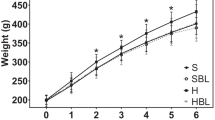Abstract
The aim of this study was to investigate the effects of persimmon-vinegar supplementation on blood lipid profiles, carnitine concentrations, and hepatic mRNA levels of enzymes involved in fatty acid metabolism. Thirty-two C57BL/6J male mice were divided into 4 groups; control group (HD), industrial vinegar group (HD-V), and persimmon-vinegar groups (HD-PV1, HD-PV2). Serum triglyceride (TG) and total cholesterol (TC) concentrations significantly decreased in all vinegar-administered groups compared with the HD group. The hepatic TG and TC concentrations of persimmon-vinegar administered groups were significantly lower compared with the HD group. Liver acid insoluble acylcarnitine (AIAC) was significantly higher in the HD-PV2 than in HD and HD-V groups. The acetyl-CoA carboxylase (ACC) mRNA level tended to lower in all the vinegar administered groups compared with the HD group. These results suggest that the persimmon-vinegar has anti-obesity properties.
Similar content being viewed by others
References
Doucet E, Tremblay A. Food intake, energy balance, and body weight control. Eur. J. Clin. Nutr. 51: 846–855 (1997)
Friedman JM, Leibel RL. Tackling a weighty problem. Cell 69: 217–220 (1992)
Park SH, Jang MJ, Hong JH, Rhee SJ, Choi KH, Park MR. Effects of mulberry leaf extract feeding on lipid status of rats fed high cholesterol diets. J. Korean Soc. Food Sci. Nutr. 36: 43–50 (2007)
Kim DH, Byun MW. Application of radiation technology on the processing of Korean traditional fermentation food. Food Ind. Nutr. 6: 38–44 (2001)
Sakanaka S, Ishihara Y. Comparison of antioxidant properties of persimmon vinegar and some other commercial vinegars in radical-scavenging assays and on lipid oxidation in tuna homogenates. Food Chem. 107: 739–744 (2008)
Xu QP, Tao WY, Ao ZH. Antioxidant activity of vinegar melanoidins. Food Chem. 102: 841–849 (2007)
Fukuyama N, Jujo S, Ito I, Shizuma T, Myojin K, Ishiwata K, Nagano M, Nakazawa H, Mori H. Kurozu moromimatsu inhibits tumor growth of Lovo cells in a mouse model in vivo. Nutrition 23: 81–86 (2007)
Fushimi T, Suruga K, Oshima Y, Fukiharu M, Tsukamoto Y, Goda T. Dietary acetic acid reduces serum cholesterol and triacylglycerols in rats fed a cholesterol-rich diet. Brit. J. Nutr. 95: 916–924 (2006)
So IC, Choi SK. The influence of persimmon vinegar and octacosanol mixture administration on exercise performance ability and blood fatigue factors. Korean J. Sport. Sci. 16: 791–802 (2007)
Moon YJ, Cha YS. Effects of persimmon-vinegar on lipid metabolism and alcohol clearance in chronic alcohol-fed rats. J. Med. Food 11: 38–45 (2008)
Kim MK, Kim MJ, Kim SY, Jung DS, Jung YJ, Kim SD. Quality of persimmon vinegar fermented by complex fermentation method. J. East Asian Soc. Diet. Life 4: 39–50 (1994)
Jeong YJ, Lee GD, Kim KS. Optimization for the fermentation condition of persimmon-vinegar using response surface methodology. Korean J. Food Sci. Technol. 30: 1203–1208 (1998)
Folch J, Lees M, Sloane Stanley GH. A simple method for the isolation and purification of total lipids from animal tissues. J. Biol. Chem. 226: 497–509 (1957)
Friedewald WT, Levy RI, Fredrickson DS. Estimation of the concentration of low-density lipoprotein cholesterol in plasma, without use of the preparative ultracentrifuge. Clin. Chem. 18: 499–502 (1972)
Cederblad G, Lindstedt S. A method for the determination of carnitine in the picomole range. Clin. Chim. Acta 37: 235–243 (1972)
Sachan DS, Rhew TH, Ruark RA. Ameliorating effects of carnitine and its precursors on alcohol-induced fatty liver. J. Clin. Nutr. 39: 738–744 (1984)
Fushimi T, Sato Y. Effect of acetic acid feeding on the circadian changes in glycogen and metabolites of glucose and lipid in liver and skeletal muscle of rats. Brit. J. Nutr. 94: 714–719 (2005)
Gorinstein S, Zemser M, Weitz M, Halevy S, Deutsch J, Tilus K, Feintuch D, Guerra N, Fishman M, Bartnikowska E. Fluorometric analysis of phenolics in persimmon. Biosci. Biotech. Bioch. 58: 1087–1092 (1994)
Gorinstein S, Bartnikowska E, Kulasek G, Zemser M, Trakhtenberg S. Dietary persimmon improves lipid metabolism in rats fed diets containing cholesterol. J. Nutr. 128: 2023–2027 (1998)
Gorinstein S, Kulasek GW, Bartnikowska E, Leontowicz M, Zemser M, Morawiec M, Trakhtenberg S. The influence of persimmon peel and persimmon pulp on the lipid metabolism and antioxidant activity of rats fed cholesterol. J. Nutr. Biochem. 9: 223–227 (1998)
Gorinstein S, Kulasek GW, Bartnikowska E, Leontowicz M, Zemser M, Morawiec M, Trakhtenberg S. The effects of diets, supplemented with either whole persimmon or phenol-free persimmon, on rats fed cholesterol. Food Chem. 70: 303–308 (2000)
Bremer J. Carnitine—metabolism and functions. Physiol. Rev. 63: 1420–1480 (1983)
Krahenbuhl S. Carnitine metabolism in chronic liver disease. Life Sci. 59: 1579–1599 (1996)
Park SH, Park TS, Cha YS. Grape seed extract (Vitis vinifera) partially reverses high fat diet-induced obesity in C57BL/6J mice. Nutr. Res. Pract. 2: 227–233 (2008)
Gornicki P. Apicoplast fatty acid biosynthesis as a target for medical intervention in apicomplexan parasites. Int. J. Parasitol. 33: 885–896 (2003)
Zang Y, Wang T, Xie W, Wang-Fischer YL, Getty L, Han J, Corkey BE, Guo W. Regulation of acetyl CoA carboxylase and carnitine palmitoyl transferase-1 in rat adipocytes. Obes. Res. 13: 1530–1539 (2005)
Fushimi T, Tayama K, Fukaya M, Kitakoshi K, Nakai N, Tsukamoto Y, Sato Y. Acetic acid feeding enhances glycogen repletion in liver and skeletal muscle of rats. J. Nutr. 131: 1973–1977 (2001)
Author information
Authors and Affiliations
Corresponding author
Rights and permissions
About this article
Cite this article
Moon, YJ., Choi, DS., Oh, SH. et al. Effects of persimmon-vinegar on lipid and carnitine profiles in mice. Food Sci Biotechnol 19, 343–348 (2010). https://doi.org/10.1007/s10068-010-0049-3
Received:
Revised:
Accepted:
Published:
Issue Date:
DOI: https://doi.org/10.1007/s10068-010-0049-3




